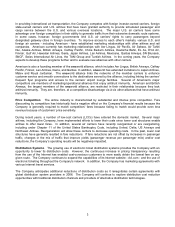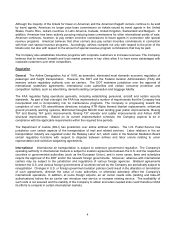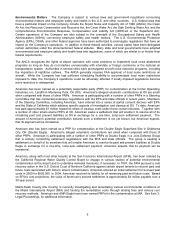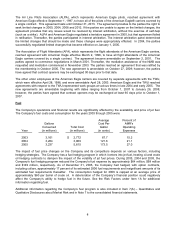American Airlines 2005 Annual Report Download - page 16
Download and view the complete annual report
Please find page 16 of the 2005 American Airlines annual report below. You can navigate through the pages in the report by either clicking on the pages listed below, or by using the keyword search tool below to find specific information within the annual report.13
The airline industry is fiercely competitive and fares are at historically low levels.
Service over almost all of our routes is highly competitive and fares remain at historically low levels. We face
vigorous, and in some cases, increasing competition from major domestic airlines, national, regional, all-cargo
and charter carriers, foreign air carriers, LCCs, and, particularly on shorter segments, ground and rail
transportation. We also face increasing and significant competition from marketing/operational alliances formed by
our competitors. In addition, the competitive landscape we face would be altered substantially by industry
consolidation, including merger, equity investment and joint venture transactions. The percentage of routes on
which we compete with carriers having substantially lower operating costs than ours has grown significantly over
the past decade, and we now compete with LCCs on 75 percent of our domestic network.
Certain alliances have been granted immunity from anti-trust regulations by governmental authorities for specific
areas of cooperation, such as joint pricing decisions. To the extent alliances formed by our competitors can
undertake activities that are not available to us, our ability to effectively compete may be hindered.
Pricing decisions are significantly affected by competition from other airlines. Fare discounting by competitors
has historically had a negative effect on our financial results because we must generally match competitors' fares,
since failing to match would result in even less revenue. More recently, we have faced increased competition
from carriers with simplified fare structures, which are generally preferred by travelers. Any fare reduction or fare
simplification initiative may not be offset by increases in passenger traffic, a reduction in costs or changes in the
mix of traffic that would improve yields. Moreover, decisions by our competitors that increase – or reduce –
overall industry capacity, or capacity dedicated to a particular domestic or foreign region, market or route, can
have a material impact on related fare levels.
We compete with reorganized and reorganizing carriers, which may result in competitive disadvantages
for us or fare discounting.
We must compete with air carriers that have recently reorganized or are reorganizing, including under the
protection of Chapter 11 of the Bankruptcy Code, including United, the second largest U.S. air carrier, Delta, the
third largest U.S. air carrier and Northwest, the fourth largest U.S. air carrier. It is possible that other competitors
may seek to reorganize in or out of Chapter 11. With the Chapter 11 filings of Delta and Northwest, two out of the
four largest U.S. air carriers are now operating under the protection of the Bankruptcy Code, with United just
having emerged from Chapter 11. We cannot reliably predict the outcome of these proceedings or the
consequences of such a large portion of the airline industry’s capacity being provided by bankrupt or recently
reorganized air carriers.
Successful reorganizations by other carriers present us with competitors with significantly lower operating costs
and a stronger financial position derived from renegotiated labor, supply, and financing contracts, which could
lead to fare reductions. These competitive pressures may limit our ability to adequately price our services, may
require us to further reduce our operating costs, and could have a material adverse impact on us.
Our reduced pricing power adversely affects our ability to achieve adequate pricing, especially with
respect to business travel.
Our passenger yield remains depressed by historical standards. We believe this depressed passenger yield is
due in large part to a corresponding decline in our pricing power. Our reduced pricing power is the product of
several factors including: greater cost sensitivity on the part of travelers (particularly business travelers); pricing
transparency resulting from the use of the Internet; greater competition from LCCs and from carriers that have
recently reorganized or are reorganizing including under the protection of Chapter 11 of the Bankruptcy Code;
other carriers being well hedged against rising fuel costs and able to better absorb the current high jet fuel prices;
and, more recently, fare simplification efforts by certain carriers. We believe that our reduced pricing power will
persist indefinitely and possibly permanently.
























